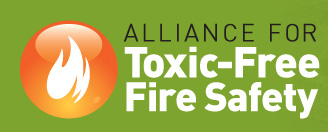  |
|||
Contact: Stephenie Hendricks 415 258-9151 shendricks@comingcleaninc.org August 28, 2014 Toxic Couch Chemicals - Right to Know Bill Passes State Legislature Label required under new legislation will give consumers information to make healthier choices (Sacramento) California became first in the nation this week to pass legislation that would require furniture labels to declare whether or not the product contains toxic flame retardant chemicals.
Senator Mark Leno (D-San Francisco) authored the bill and California Professional Firefighters (CPF), Center for Environmental Health (CEH) and the Natural Resources Defense Council (NRDC) are co-sponsors. The chemical industry launched a strong campaign to defeat the bill, but the bill’s bipartisan support throughout the legislature indicates that both sides of the aisle agree—more transparency in the marketplace is good for consumers and good for business.
A wide variety of organizations representing business, health, fire safety, consumers and the environment support the bill, including the American Home Furnishings Alliance, a trade group for furniture manufacturers, Physicians for Social Responsibility-Los Angeles (PSR-LA), Environmental Working Group (EWG),Consumer Federation of Californiand the Alliance for Toxic Free Fire Safety. The bill now heads to the desk of Gov. Jerry Brown. “Nobody knows better than firefighters about the health effects of environmental toxins -- every year, firefighters are diagnosed with job-related cancer linked to exposure to these chemicals,” said Lou Paulson, president of CPF. “SB 1019 helps ensure that every Californian knows whether toxic chemicals are being used in upholstered furniture, and have the option to make a safer choice.” “As a scientist who works to protect the public from hazardous chemicals in products, it’s exciting that the legislature agrees that consumers should have the information they need to say ‘no’ to toxics in their homes,” says Veena Singla, Ph.D., staff scientist with NRDC. “Flame retardants don’t stay in furniture—they migrate out, collect in dust and enter our bodies when we contact the contaminated dust. These chemicals are associated with a variety of serious health risks, including cancer, hyperactivity and reduced IQ.” Judy Levin, MSW, Pollution Prevention Program Co-Director for CEH adds, “Our testing over the past five years has found that much of the furniture we buy is doused with high levels of toxic flame retardant chemicals. Many studies have found toxic flame retardants in our bodies, including in pregnant women and children. Parents and other consumers have a right to know when these toxic chemicals are used in furniture. We expect Governor Brown to sign this bill into law.” Consumer Federation of California Executive Director Richard Holober adds, “The disclosure of whether or not a product contains flame retardant chemicals serves the public’s interest, builds consumer confidence, and creates greater transparency in the marketplace.” "California has held the unfortunate distinction of having some of the highest levels of flame retardants ever measured in our homes, wildlife and people, including children. Much of this contamination stems from the use of flame retardant chemicals in our furniture and it is harming our health,” says Sarah Janssen, M.D., Ph.D., M.P.H., a practicing physician, reproductive health researcher at University of California, San Francisco, and mother. Martha Dina Arguello from PSR-LA says, “Labels are important because the toxic legacy of a flame retardant couch gets passed on for decades—people often buy or are gifted second hand furniture. Now, since these labels will stick with furniture, these consumers can also make informed decisions.” “Our recent study found that young children carry on average 5 times higher levels of flame retardants than their mothers,” Bill Allayaud, EWG’s California Director of Government Affairs said. “Labeling will give parents a visible choice so that they don’t bring a toxic couch or chair into their family’s home.” "We know from our extensive biomonitoring projects here at Commonweal that these toxic flame retardants from the past are persistent in our bodies. Labeling helps people understand what they are exposing themselves to before they buy their furniture, so they can avoid more chemicals within their bodies," said Sharyle Patton, founder, Commonweal Biomonitoring Resource Center. Kathleen A. Curtis, L.P.N., of Clean and Healthy New York and coordinator of the national Alliance for Toxic Free Fire Safety adds, "This measure has nationwide implications. Parents and other consumers in many states are working with their state governments to curb the exposure to toxic flame retardants. Now that the obsolete California regulation has been modernized, all shoppers nationwide need to know if flame retardants remain in the furniture they wish to purchase. This bill is a great step in the right direction for safer furniture all across the country." For more info: www.toxicfreefiresafety.org Available for Interviews Michael Green, Executive Director, Center for Environmental Health, maggie@ceh.orgm 510.655.3900 ext. 302. Veena Singla, Ph.D., Staff Scientist, Natural Resources Defense Council 469.236.5549vsingla@nrdc.org. Kimiko Martinez, 310.434.2344 kmartinez@nrdc.org can also assist with reaching Dr. Singla. Dr. Singla can address the emerging scientific studies about toxic flame retardant chemicals. Carroll Wills, California Professional Firefighters, 916.921.9111, cwills@cpf.org. Carroll can address toxic exposures firefighters face, and the need for fire safety without the use of toxic chemicals. Sarah Janssen, M.D., Ph.D., M.P.H., Assistant Clinical Professor, University of California, San Francisco, 415.722.0120, sarah.janssen@ucsf.edu. Dr. Janssen can discuss health impacts linked to flame retardant chemicals and her research on chemicals and reproductive health. Martha Dina Argüello, Executive Director, Physicians for Social Responsibility — Los Angeles, CA. marguello@psr-la.org.310 261-0073 Richard Holober, Executive Director, Consumer Federation of California, 916.498.9608 holober@consumercal.org ` Sharyle Patton, Founder, Commonweal Biomonitoring Resource Center, 415.868.0970 x728, spatton@igc.org Kathleen A. Curtis, LPN, National Coordinator of Alliance for Toxic Free Fire Safety, 518.708.3922, kathy@cleanhealthyny.org |
|||




